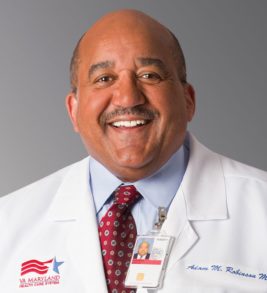
Adam M. Robinson Jr., MD, the newly minted director of the VA Pacific Islands Healthcare System
HONOLULU — Adam M. Robinson Jr., MD, the newly minted director of the VA Pacific Islands Healthcare System, has a story about a three-legged stool. It’s one that he tells enough that his employees end up learning it by heart.
“Our concept of care sits on a three-legged stool. Those legs are patients, family, and staff. One of the things I’ve noticed is that at a lot of places, staff are second-class or in some ways aren’t included in the care continuum in an affirmative way. I want an affirmed, educated, respected staff so that they can give what we need to give to the patients and the patients’ families. Those legs have to be symmetrical. It’s very much an integrated process and makes for a dynamic progression of activities and care continuum for the patients.”
It’s a philosophy that he’s carried with him through a 30-year career in the Navy—one that culminated in his serving as the 36th surgeon general of the Navy and retiring a vice admiral—and into his life as a senior leader at VA.
Robinson arrived at VA in 2014 as chief of staff at the Baltimore VAMC. That year, a scandal broke at the Phoenix VA that revealed some facilities were manipulating data about veteran wait times to make it seem as if fewer veterans were waiting long periods to see a doctor. Consequently, a number of leaders at facilities nationwide resigned, including the then-director in Baltimore. Robinson became acting director and six months later was confirmed in the position.
“Baltimore was the fifth or sixth large medical center I’ve run in my career,” Robinson said. “I’ve just been very successful at medical centers. Partly because I love people and I love patients and I understand the flow and dynamics of medical centers. It doesn’t upset me to deal with the HR issues and the issues with the staff.”
Robinson credits his three-legged stool philosophy—where staff play an equal role in the life of a VA facility—to increasing employee morale, as well as increasing the number of veterans served and the quality of care during his time there.
Now he’s looking to take that philosophy to the Pacific Islands. Headquartered in Honolulu, Robinson will oversee 1,400 employees tasked with the care of 129,000 veterans. While this represents less than half the employees who served under him in Baltimore, the logistics and challenges remain the same, with less room for error.
“In a smaller place, it means that the four or five physicians that I need to hire could represent a critical number,” Robinson explained. “The smaller numbers mean I have a greater chance of having disastrous problems if I don’t get a hold of the efficiencies and understand exactly how we’re working from a resource perspective.”
While Baltimore was a single medical center based squarely in a large city, the Pacific Islands Healthcare System is spread out over 2.6 million square miles. In addition to the Sparks Matsunaga VAMC in Honolulu, the network includes an ambulatory care clinic in Oahu and seven community-based outpatient clinics in the Hawaiian Islands, as well as Maui, American Samoa and Guam.
The pressure to get a handle on the unique workings of the system is only heightened by the ongoing pandemic.
“COVID-19 is a really dangerous time, especially as we start flu season. That’s a difficult time for my veterans. Many are elderly and many have comorbidities,” Robinson said. “Every year in Baltimore I begged my staff to get their flu shot. We had 30% compliance perhaps. But I really wanted that 90% or 100%. And I could never get it.”
Robinson hopes to achieve that goal in the Pacific Islands to ease the pressure of flu season and make more room for treating COVID-19 patients.
Robinson will also need to get up to speed on the dynamics between the VAMC and Tripler Army Medical Center, which are collocated in Honolulu. Inpatient care for veterans is provided by both VA and DoD physicians through a sharing agreement.
“Having spent many of my prior years on the DoD side, I’m very pleased to be at Tripler,” Robinson said. “[VA] is an extension of my active duty years and I’ve been learning how veterans and our active duty mesh together. We have a comprehensive system to care for them and that really does need tending.”

